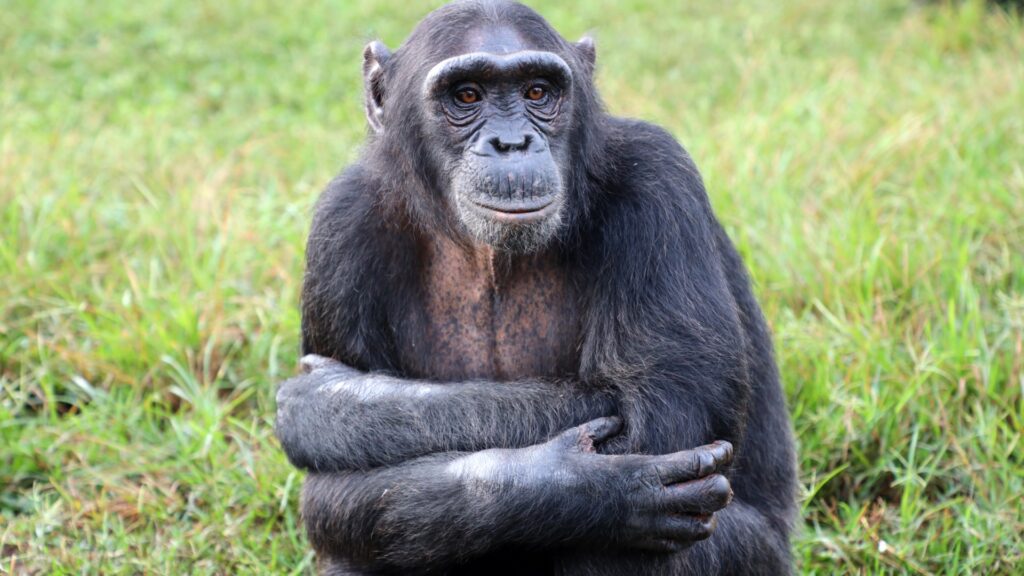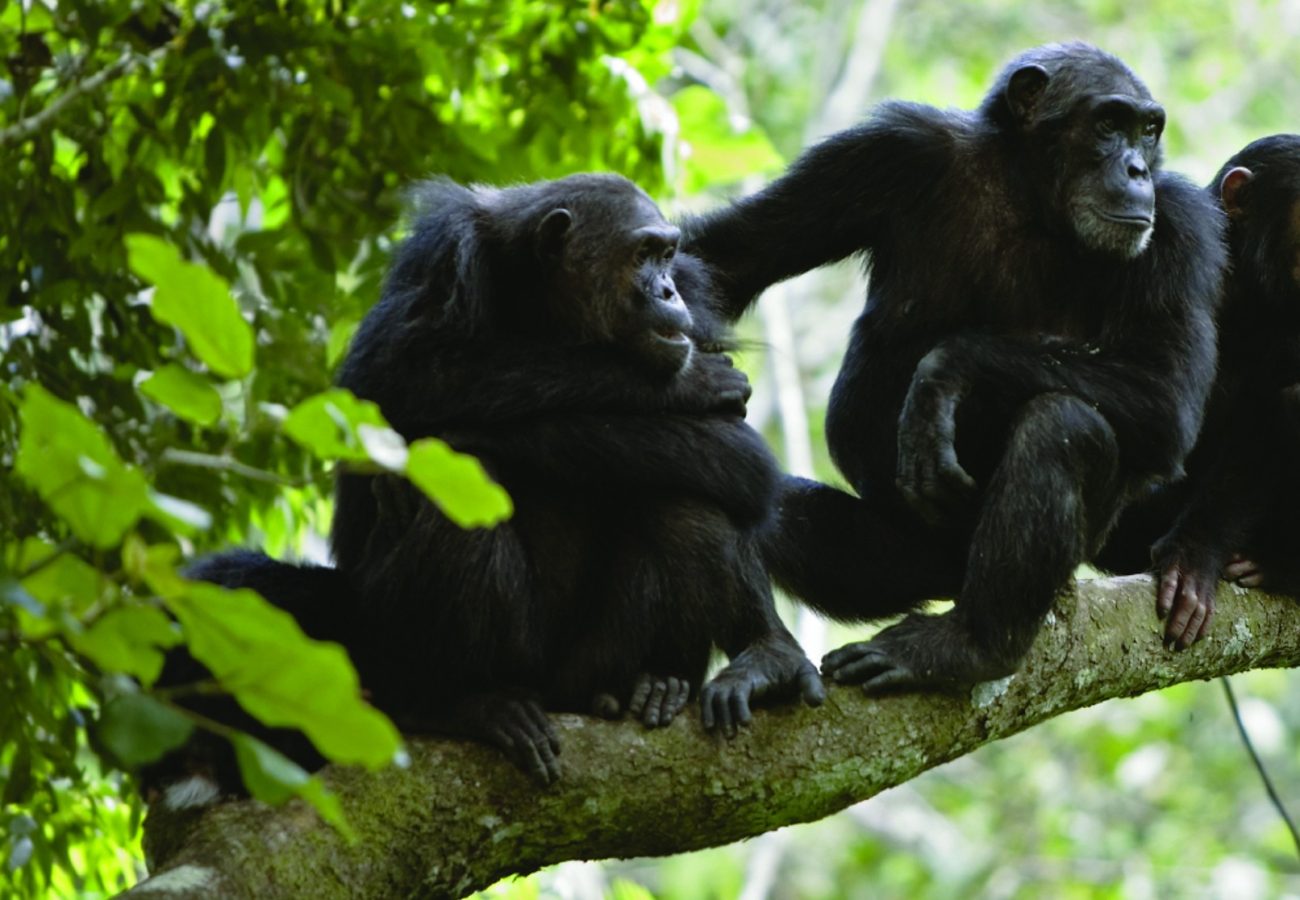30 Chimpanzee Facts - Perfect for Kids & Adults
Chimpanzees are one of our closest animal relatives. Living in the forests and grasslands of Africa, these intelligent primates are very social, can use tools and communicate in many ways. Find out more about these fascinating apes below!

(c) CSWCT
1. Chimpanzees are great apes
Chimpanzees belong to the great ape family. Other great apes including gorillas, orangutans, bonobos and humans.
2. Their scientific name is Pan troglodytes
Chimpanzees are in the Pan genus. Along with bonobos, these two species are the only living members of the genus. Currently we don’t know of any extinct species of the Pan genus.
3. Chimpanzees share up to 98.7% of our DNA
Humans closest living relatives are chimpanzees and bonobos. Chimpanzees are genetically closer to humans than gorillas. Like humans, chimpanzees are very intelligent, displaying advanced cognitive and emotional abilities.
4. Chimps and humans share a common ancestor
Our common ancestors diverged (separated) approximately 6.5-7 million years ago. After this, humans and chimpanzees began to evolve differently. Evolution is how living things have changed and grown over a long time, starting from the same early ancestors. As humans and chimpanzees evolved, we began to become different. For example, humans can now walk upright on only our feet, while chimpanzees walk on all fours, using their hands and feet.
5. They live in 21 African countries
They range across equatorial Africa, in countries such as Uganda, Cameroon and the Democratic Republic of Congo.
6. Chimpanzees have the widest geographical distribution of any great ape
Chimpanzees can be found from West Africa, all the way to Tanzania. Their distribution is not continuous however, and many populations are restricted to areas as a result of habitat destruction, caused by humans.
7. There are four subspecies of chimpanzees
These subspecies are the Western Chimpanzee (Pan troglodytes verus), Nigeria-Cameroon Chimpanzee (Pan troglodytes ellioti), Eastern Chimpanzee (Pan troglodytes schweinfurthii) and the Central Chimpanzee (Pan troglodytes troglodytes).
8. Chimpanzees are endangered
According to the IUCN, chimpanzees are Endangered. It is estimated that fewer than 300,000 individuals remain in the wild, with this continuing to decline due to habitat loss, poaching, disease, and human conflict.
9. They can live up to 45 years in the wild
The average life expectancy of chimpanzees in the wild is around 33 years but some individuals, often females, can live many years longer. Our partners the Bulindi Chimpanzee and Community Project recorded a female in one of their monitored groups who was in her mid-40s. One of the oldest recorded wild chimpanzees was Auntie Rose, in Kibale, Uganda, who was estimated to be around 63 years old when she died.
10. Chimpanzees are highly social animals
Chimpanzees live in communities, composed of adults of both sexes and juveniles. The groups are complex and led by a dominant male. At around 13 years old, female chimpanzees usually leave their natal group (the group they were born in) to look for another group to move in to. By doing this, they ensure there is a lower risk of mating with their relatives.
11. Chimps form sub-groups
Chimpanzees display fission-fusion societies. This is a type of social structure, where groups will split (fission) into smaller sub-groups for feeding, travelling, or resting. These sub-groups are flexible with the size and composition of the groups changing frequently. These sub-groups can then come together (fusion) into larger groups.
12. Chimpanzees patrol their home range boundary
Male chimpanzees in particular, will travel to the periphery (border) of their home range to patrol its boundary. These patrols appear to be the group searching for signs of chimpanzees from other groups, who could be intruders into their territory.
13. Each chimp has a unique personality
Like humans, chimpanzees all have their own personalities. Some chimpanzees will be more confident and bolder, while others are shy or playful.
14. They communicate in many ways
Chimpanzees communicate through vocalisations, gestures and facial expressions. Some of their vocalisations can be loud screams, often accompanied by large movements, while others can be quiet grunts. A ‘pant-hoot’ is a complex, loud vocalisation produced by chimpanzees, which has four distinct phases: the introduction, build-up, climax and let-down.
15. Grooming is very important
Chimpanzees, like many primates, groom each other. While grooming does have a hygienic benefit, it’s main purpose is to build and maintain social bonds. For primates, the amount of grooming time between individuals is broadly an indicator of relationship quality.
16. Chimpanzees use tools
Many groups of chimpanzees in the wild have been recorded using tools such as twigs and stones. They have also been observed making tools – where they alter an object before using it. These tools have a wide range of uses and are often used to access food, such as dipping twigs in honey or ant nests or using stones to pound nuts.
17. Jane Goodall discovered chimp tool use
In 1960, Dr Jane Goodall was the first person to observe chimpanzees using tools in Gombe, Tanzania where she was studying a group of wild chimpanzees. Before this, the ability to use and make tools was thought to be restricted to humans.
18. Chimps can learn sign language
In captivity, some chimpanzees have been taught human sign language, which they have then used to communicate with human caregivers and other chimpanzees.
19. Chimpanzees hunt
Chimpanzees usually hunt socially, in a ‘hunting party’, with each member of the group having a different role in the hunt. It will depend on their environment and individuals as to how frequently a group of chimpanzees’ hunt. Prey species include other primates such as red-colobus monkeys, red-tailed monkeys or olive baboons, or smaller mammals such as antelopes like duikers or bushbucks.
20. Chimps build tree nests
Each night, chimpanzees build nests most days for resting and sleeping in. Building a nest involves breaking, bending and weaving branches into a circular frame, before tucking some smaller branches in to form a sturdy platform. The purpose of the nests could be to act as an anti-predator strategy.
21. Chimpanzees knuckle-walk
They usually walk on all fours and do this with their knuckles on the ground. This type of movement is called ‘knuckle-walking’. They can walk upright for short distances but are not adapted to bi-pedal (walking on their feet) movement, like humans are.
22. Females give birth to one baby
During their first few months, a baby chimpanzee will cling to the hair of their mother’s chest for transport. After a few months, they will change to riding on their mothers back when travelling and continue to travel like this for a number of years.
23. Weaning happens between ages 3 to 7
Chimpanzees normally stop taking milk from their mothers when they are between 3-7 years old. They will stay with their mothers and usually have a close relationship for several years after weaning. There is a lot to learn in chimpanzee society, and infants will learn survival skills from their mothers, siblings and other relatives.
24. Chimpanzee mothers teach their offspring how to use tools
Chimpanzee mothers have been observed showing their offspring how to use tools correctly, such as how to crack open a nut or how to use sticks to fish for termites.
25. Female Chimpanzees reach maturity at 13
Males take longer, about 15 years to reach full maturity. Although chimpanzees can breed before they reach maturity, they continue to develop socially and physically until they are mature.
26. Chimpanzees will form alliances
Male chimpanzees will form coalitions with other males, with this thought to help improve their social rank or access to resources such as food.
27. Chimps are omnivorous
Chimpanzees have a wide diet, including fruit, nuts, seeds, insects, flowers, honey and meat.
28. Chimps face serious threats
Poaching is the biggest threat to chimpanzees, despite it being illegal to kill, capture or consume any great ape. When chimpanzees are killed, their infants are often taken for the pet trade. These infants are very traumatised, having watched their family be killed and then put in unsuitable conditions. Our partners, Ape Action Africa, Ngamba Island and Limbe Wildlife Centre all provide homes for chimpanzees, many who have been rescued from the pet trade. Other threats to chimpanzees include habitat destruction, bushmeat hunting, human conflict, and disease (like Ebola).
29. Chimpanzees should never be pets
Chimpanzees are cute, but they should never be kept as a pet. They are wild animals, who should be allowed to lively freely in their natural environments. Chimpanzees are highly social animals and need live with other chimpanzees. Their behaviour can be unpredictable, and their strength makes them dangerous, even when they are not trying to be aggressive.
30. There are a lot of chimpanzees in the U.S.
There are a huge number of chimpanzees living in the USA. This is because many were used in research labs or for entertainment and some still are. Luckily, the number of chimpanzees in research labs is declining and less chimpanzees are used for entertainment. Sanctuaries are now home to over 1,000 chimpanzees who have been retired from lab or entertainment work.

JUNGLE NOT JAIL FOR OUR CLOSEST COUSINS
Will you stand up for great apes and pledge never to visit a facility which keeps them captive for entertainment?
